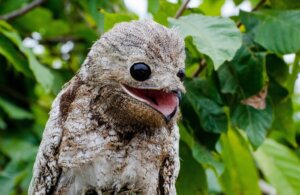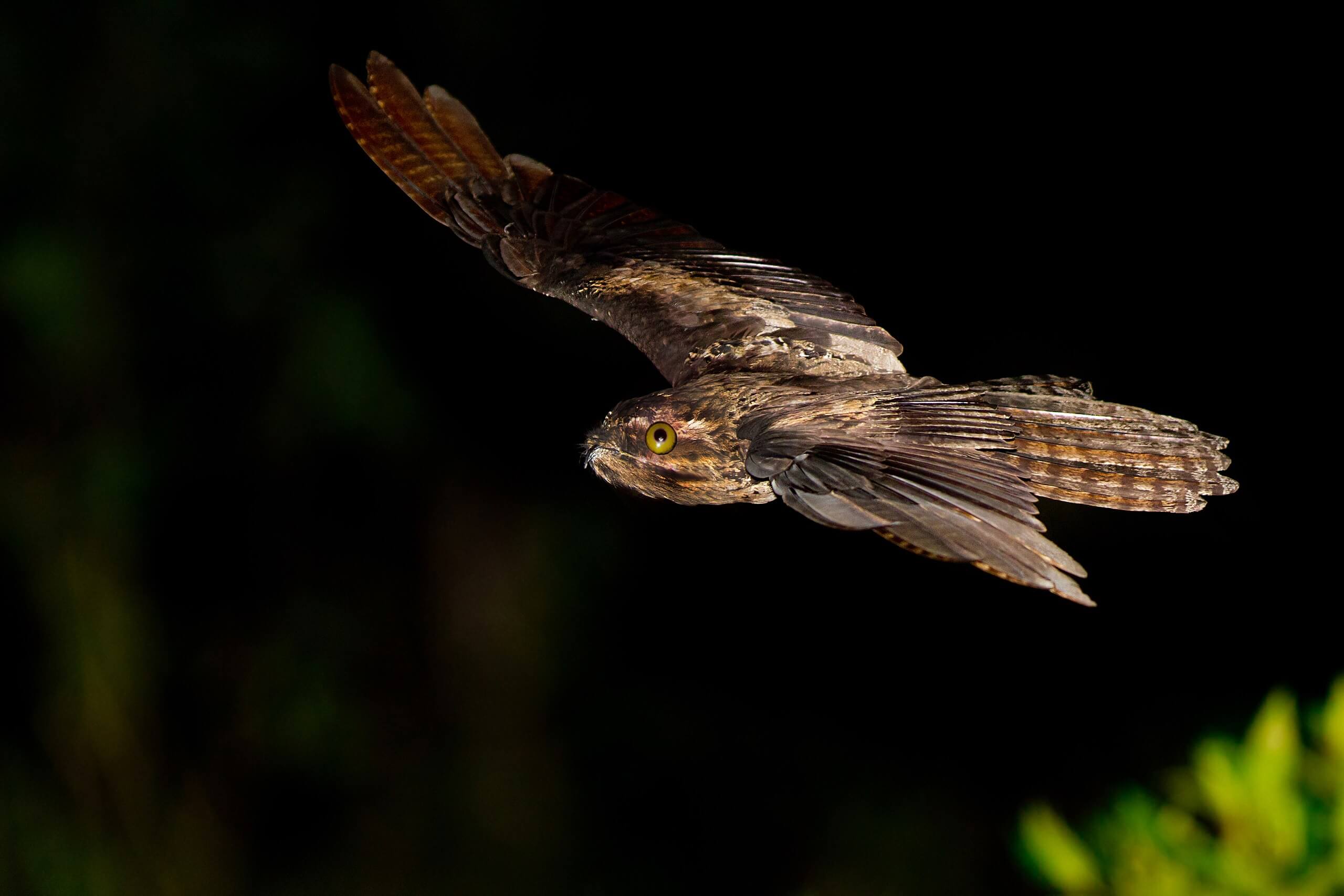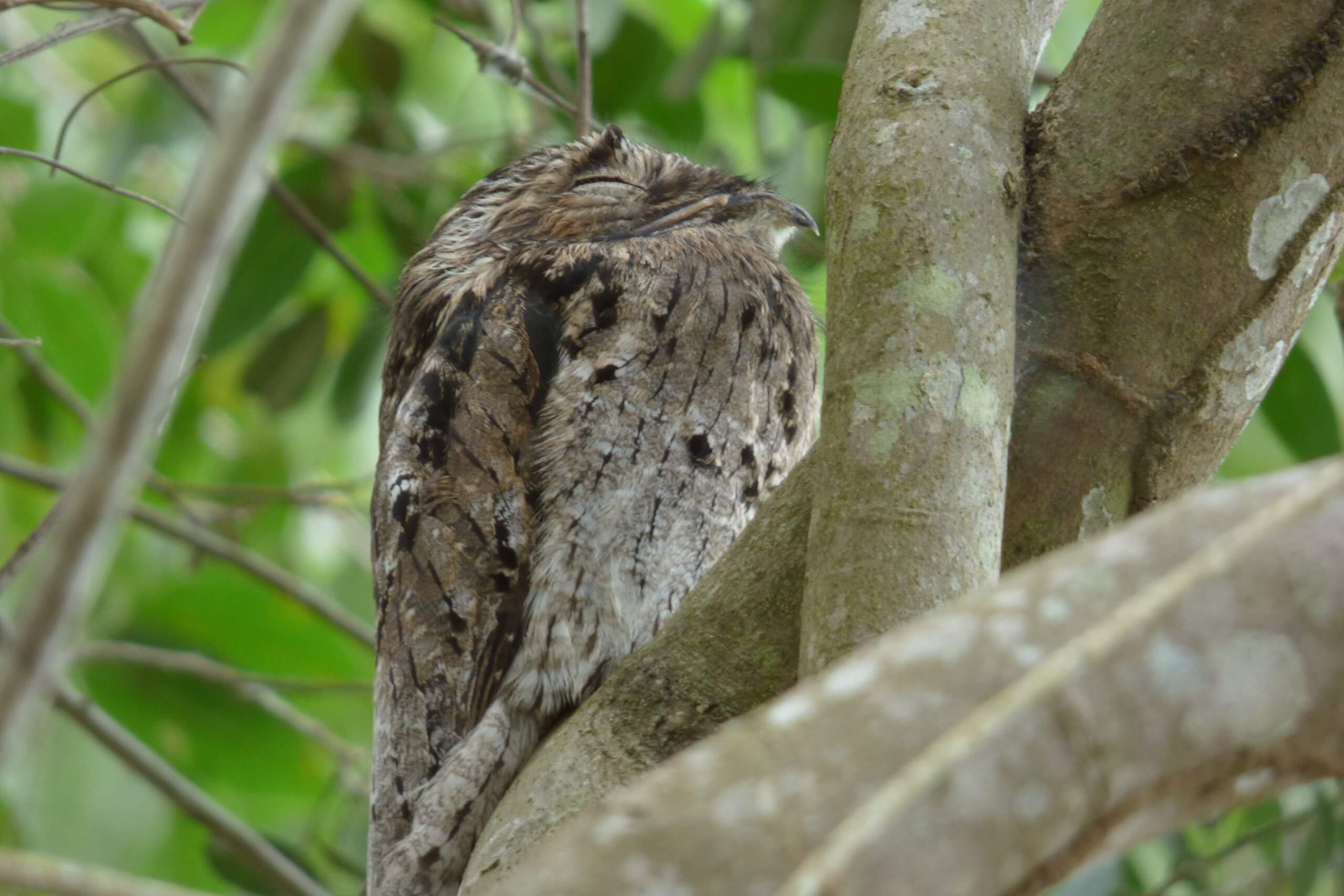The Potoo or Ghost Bird: Characteristics, Habitat and Unique Song


Written and verified by the biologist Georgelin Espinoza Medina
The name potoo, urutaú or “ghost bird” refers not only to one species of bird, but to several with similar characteristics. The name comes from its peculiar appearance and behavior, which allows it to camouflage itself very well with its environment, as well as to go unnoticed. Find out all about the potoo – you’ll be amazed!
It has a dark plumage, which allows it to hide in its natural habitat. This characteristic is complemented by its behavior, as it remains motionless for most of the day. Learn a little more about the biology and lifestyle of this bird in the following lines.
Taxonomy of the potoo
These birds are included in the family Nictibiidae and in the order Nyctibiiformes. Previously they were taxonomically placed within the Caprimulgiformes, but some scientific evidence, such as the more pronounced curvature of the jugular arches of the mandibles (among other characteristics), meant they needed a separate classification.
The group consists of only two genera: Nyctibius and Phyllaemulor. The latter comes from recent scrutiny of the characteristics of these animals.
Species that make up the family

The species list of Nyctibius isn’t very numerous, with only 7 specimens, 6 belonging to the genus Nyctibius and 1 to the genus Phyllaemulor:
- Great potoo (Nyctibius grandis)
- White-winged potoo (Nyctibius leucopterus)
- Long-tailed potoo (Nyctibius aethereus)
- Northern potoo (Nyctibius jamaicensis)
- Andean potoo (Nyctibius maculosus)
- Common potoo (Nyctibius griseus)
- Rufous potoo (Phyllaemulor bracteatus)
Characteristics of the potoo
This bird, also known as the ghost bird, is characterized by its opaque coloration, not at all showy, because it has the purpose of keeping them hidden from threats.
In general, the tones are brown, gray, with designs streaked with black and white. It’s also possible to observe reddish plumage, as is the case of the rufous potoo (P. bracteatus), which is believed to imitate the foliage or dead wood of its environment.
They have a large head and eyes (in relation to the size of the body), as well as a short, wide beak. They also have long tails and wings.
They’re nocturnal animals, which during the day remain motionless, standing on vertical trunks, while imitating branches, and protected by their cryptic coloration. Their vision is adapted to see everything clearly at night.
These birds are similar in their morphology and biology. The behavior that varies most in the family is in the case of the rufous potoo, as it adopts a rather hunched posture on horizontal branches and tends to rock back and forth, regularly, while mimicking the movement of dead leaves in the breeze. This is explained in the Journal of Avian Biology.
Habitat of the potoo

Potoos are neotropical birds. They’re found in the Americas, from Mexico to South America (except Chile).
The geographic range of the different species that make up the family generally overlaps. They often inhabit lowland rainforests, but Andean specimens (N. maculosus) live in montane rainforests.
What does the potoo eat?
Potoos are insectivorous birds, meaning they eat insects. They usually feed in the forest canopy, while the rufous potoo prefers lower down.
They like to catch beetles and moths. In addition, the Animal Diversity Web also claims that great potoos may consume bats on occasion.
Song of the potoo

One of the most interesting characteristics of the potoo is its vocalization. Their song is similar to a wail or a terrifying scream, which is why they are the protagonists of several myths and legends in the different localities where they are located.
The American Bird Conservancy notes that in Peru the sound they emit is related to the story of a lost child calling its mother. The vocalizations of these birds also present certain particularities in the different species.
Reproduction
There are few records and observations regarding the reproduction of these birds. However, it’s known that these birds don’t build nests, but lay their eggs (one per clutch) in depressions in branches, both in dead and living trees. Also, there’s parental care by both parents.
Some research has found that their white, elliptical eggs with spots of different sizes (gray, lilac and brown) were laid in a shallow depression in a knot 5 meters above the ground in a laurel tree.
Conservation status of the ghost bird
The potoo, or ghost bird, isn’t endangered. This is reported by the International Union for Conservation of Nature (IUCN) for all species of the family. Therefore, it’s classified in the “least concern” category. Despite this, there’s a decreasing trend in the number of individuals in its population.
Seven species of birds of the family Nyctibiidae can be included under the name of ghost bird or potoo. These specimens are interesting for their cryptic plumage, and their stealthy and immobile behavior, in order to go unnoticed.
In addition, their special song is a terrifying sound that’s often heard under the moonlight and has inspired several local legends. Regarding this curious bird, much remains to be discovered about its biology and behavior.
The name potoo, urutaú or “ghost bird” refers not only to one species of bird, but to several with similar characteristics. The name comes from its peculiar appearance and behavior, which allows it to camouflage itself very well with its environment, as well as to go unnoticed. Find out all about the potoo – you’ll be amazed!
It has a dark plumage, which allows it to hide in its natural habitat. This characteristic is complemented by its behavior, as it remains motionless for most of the day. Learn a little more about the biology and lifestyle of this bird in the following lines.
Taxonomy of the potoo
These birds are included in the family Nictibiidae and in the order Nyctibiiformes. Previously they were taxonomically placed within the Caprimulgiformes, but some scientific evidence, such as the more pronounced curvature of the jugular arches of the mandibles (among other characteristics), meant they needed a separate classification.
The group consists of only two genera: Nyctibius and Phyllaemulor. The latter comes from recent scrutiny of the characteristics of these animals.
Species that make up the family

The species list of Nyctibius isn’t very numerous, with only 7 specimens, 6 belonging to the genus Nyctibius and 1 to the genus Phyllaemulor:
- Great potoo (Nyctibius grandis)
- White-winged potoo (Nyctibius leucopterus)
- Long-tailed potoo (Nyctibius aethereus)
- Northern potoo (Nyctibius jamaicensis)
- Andean potoo (Nyctibius maculosus)
- Common potoo (Nyctibius griseus)
- Rufous potoo (Phyllaemulor bracteatus)
Characteristics of the potoo
This bird, also known as the ghost bird, is characterized by its opaque coloration, not at all showy, because it has the purpose of keeping them hidden from threats.
In general, the tones are brown, gray, with designs streaked with black and white. It’s also possible to observe reddish plumage, as is the case of the rufous potoo (P. bracteatus), which is believed to imitate the foliage or dead wood of its environment.
They have a large head and eyes (in relation to the size of the body), as well as a short, wide beak. They also have long tails and wings.
They’re nocturnal animals, which during the day remain motionless, standing on vertical trunks, while imitating branches, and protected by their cryptic coloration. Their vision is adapted to see everything clearly at night.
These birds are similar in their morphology and biology. The behavior that varies most in the family is in the case of the rufous potoo, as it adopts a rather hunched posture on horizontal branches and tends to rock back and forth, regularly, while mimicking the movement of dead leaves in the breeze. This is explained in the Journal of Avian Biology.
Habitat of the potoo

Potoos are neotropical birds. They’re found in the Americas, from Mexico to South America (except Chile).
The geographic range of the different species that make up the family generally overlaps. They often inhabit lowland rainforests, but Andean specimens (N. maculosus) live in montane rainforests.
What does the potoo eat?
Potoos are insectivorous birds, meaning they eat insects. They usually feed in the forest canopy, while the rufous potoo prefers lower down.
They like to catch beetles and moths. In addition, the Animal Diversity Web also claims that great potoos may consume bats on occasion.
Song of the potoo

One of the most interesting characteristics of the potoo is its vocalization. Their song is similar to a wail or a terrifying scream, which is why they are the protagonists of several myths and legends in the different localities where they are located.
The American Bird Conservancy notes that in Peru the sound they emit is related to the story of a lost child calling its mother. The vocalizations of these birds also present certain particularities in the different species.
Reproduction
There are few records and observations regarding the reproduction of these birds. However, it’s known that these birds don’t build nests, but lay their eggs (one per clutch) in depressions in branches, both in dead and living trees. Also, there’s parental care by both parents.
Some research has found that their white, elliptical eggs with spots of different sizes (gray, lilac and brown) were laid in a shallow depression in a knot 5 meters above the ground in a laurel tree.
Conservation status of the ghost bird
The potoo, or ghost bird, isn’t endangered. This is reported by the International Union for Conservation of Nature (IUCN) for all species of the family. Therefore, it’s classified in the “least concern” category. Despite this, there’s a decreasing trend in the number of individuals in its population.
Seven species of birds of the family Nyctibiidae can be included under the name of ghost bird or potoo. These specimens are interesting for their cryptic plumage, and their stealthy and immobile behavior, in order to go unnoticed.
In addition, their special song is a terrifying sound that’s often heard under the moonlight and has inspired several local legends. Regarding this curious bird, much remains to be discovered about its biology and behavior.
All cited sources were thoroughly reviewed by our team to ensure their quality, reliability, currency, and validity. The bibliography of this article was considered reliable and of academic or scientific accuracy.
- American Bird Conservancy. (2023). Common potoo. Consultado el 30 de mayo de 2023. https://abcbirds.org/bird/common-potoo/
- BirdLife International. (2020). Nyctibius grandis. The IUCN Red List of Threatened Species 2020: e.T22689636A163599353. https://www.iucnredlist.org/species/22689636/163599353
- Chen, A., & Field, D. (2020). Phylogenetic definitions for Caprimulgimorphae (Aves) and major constituent clades under the International Code of Phylogenetic Nomenclature. Vertebrate Zoology, 70(4), 571-585. https://www.senckenberg.de/de/wissenschaft/publikationen/wissenschaftliche-zeitschriften/vertebrate-zoology/archiv/vz-70-4-03/
- Costa, T., Whitney, B., Braun, M., White, N., Silveira, L., & Cleere, N. (2018). A systematic reappraisal of the Rufous Potoo Nyctibius bracteatus (Nyctibiidae) and description of a new genus. Journal of Ornithology, 159(2), 367–377. http://www.noorwhite.com/uploads/7/4/8/4/74845011/costa_et_al_2017.pdf
- Díaz, L., & Moresco, D. (2021). Primer registro de nidificación del Urutaú coludo (Nyctibius aethereus) en Argentina. Nuestras Aves, 66, 58-64. https://nuestrasaves.avesargentinas.org.ar/index.php/home/article/view/53
- Martínez, O., Garrido, O., Reynard, G., Suarez, W., Kirkconnell, A., Wiley, J. (2000). A new family and genus of bird (Aves: Caprimulgiformes: Nyctibiidae) for Cuba. Journal of Caribbean Ornithology, 13(3). https://jco.birdscaribbean.org/index.php/jco/article/view/611
- Slusher, G. (2008). Nyctibius grandis. Animal Diversity Web. Consultado el 30 de mayo de 2023. https://animaldiversity.org/accounts/Nyctibius_grandis/
- White, N., Mitter, C., & Braun, M. (2017). Ultraconserved elements resolve the phylogeny of potoos (Aves: Nyctibiidae). Journalof Avian Biology, 48, 872-880. http://www.noorwhite.com/uploads/7/4/8/4/74845011/white_et_al-2017-journal_of_avian_biology.pdf
- Zárate, V., Juncosa, P., & Agostina, S. (2021). Vocal activity of the great potoo (Nyctibius grandis) in relation to moonlight detections in Costa Rica. Ornitología Neotropical, 32, 74-76. https://ri.conicet.gov.ar/handle/11336/178495
This text is provided for informational purposes only and does not replace consultation with a professional. If in doubt, consult your specialist.








